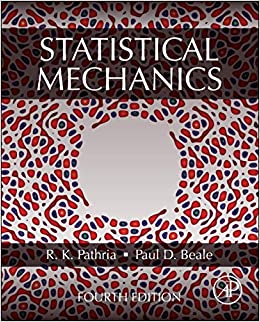Following expressions (12.5.2), define [begin{equation*}p=(1+L) / 2 quad text { and } quad q=(1-L) / 2 quad(-1
Question:
Following expressions (12.5.2), define
\[\begin{equation*}p=(1+L) / 2 \quad \text { and } \quad q=(1-L) / 2 \quad(-1 \leq L \leq 1) \tag{1}\end{equation*}\]
as the probabilities that a spin chosen at random in a lattice composed of \(N\) spins is either "up" or "down." The partition function of the system may then be written as
\[\begin{equation*}Q(T, H)=\sum_{L} g(L) e^{\beta N\left(\frac{1}{2} q J L^{2}+\mu \mu_{0} H L\right)} \tag{2}\end{equation*}\]
where \(g(L)\) is the multiplicity factor associated with a particular value of \(L\), that is,
\[\begin{equation*}g(L)=N ! /(N p) !(N q) ! \tag{3}\end{equation*}\]
note that in writing the Hamiltonian here we have made the assumption of random mixing, according to which
\[\left(N_{++}+N_{--}-N_{+-}\right)=\frac{1}{2} q N\left(p^{2}+q^{2}-2 p q\right)=\frac{1}{2} q N L^{2} .\]
(a) Determine the value, \(L^{*}\), of \(L\) that maximizes the summand in (2). Check that \(L^{*}\) is identical to the mean value, \(\bar{L}\), as given by equation (12.5.10).
(b) Write down the free energy \(A\) and the internal energy \(U\) of the system, and show that the entropy \(S\) conforms to the relation
\[S(T, H)=-N k\left(p^{*} \ln p^{*}+q^{*} \ln q^{*}\right),\]
where \(p^{*}=p\left(L^{*}\right)\) and \(q^{*}=q\left(L^{*}\right)\).
Step by Step Answer:






